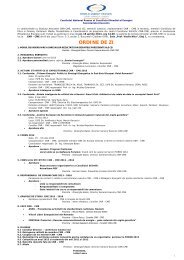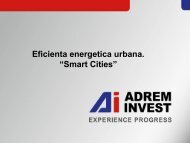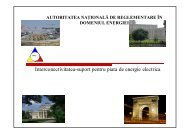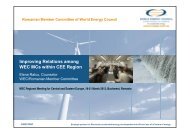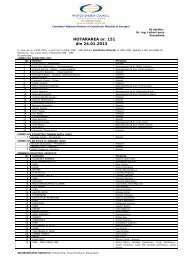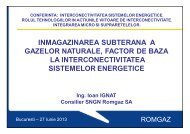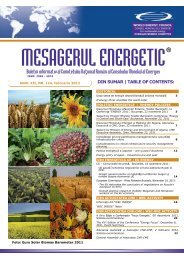You also want an ePaper? Increase the reach of your titles
YUMPU automatically turns print PDFs into web optimized ePapers that Google loves.
M E S A G E R U L E N E R G E T I C<br />
•Smart buildings and neigh -<br />
bourhood projects. They can for<br />
example integrate and manage<br />
local and renewable energy<br />
sources. They could expand the<br />
use of high efficiency heating<br />
and cooling (using biomass, solar<br />
thermal, ambient thermal and<br />
geothermal heat storage, cogeneration<br />
and district heating).<br />
They could also support the<br />
construction of nearly zeroenergy<br />
buildings and positive<br />
energy buildings and neigh -<br />
bourhoods.<br />
•Smart supply and demand<br />
service projects. Funding could<br />
be available for sche<strong>me</strong>s which<br />
provide data and information to<br />
citizens and end-users on energy<br />
consumption/production and<br />
multimodal transport and<br />
mobility services; to develop<br />
smart <strong>me</strong>tering and related<br />
services for energy, water, waste;<br />
monitoring and balancing the<br />
grid; or energy storage (including<br />
virtual energy storage)<br />
•Urban mobility projects. These<br />
could be electric public transport<br />
vehicles (for example trolley<br />
buses, trams, <strong>me</strong>tro vehicles)<br />
that are able to exchange surplus<br />
energy (braking and accelerating<br />
energy) with the energy system.<br />
They could be using ICT to<br />
manage energy flows or using<br />
hydrogen as an energy carrier for<br />
storing energy and balancing<br />
demand at city level for energy<br />
and stationary power – controlled<br />
by ICT using forecasts for<br />
demand patterns based on<br />
weather forecasts, event<br />
planning, vehicle route patterns,<br />
etc.<br />
•Smart and sustainable digital<br />
infrastructures. By reducing the<br />
carbon footprint of the Internet,<br />
in particular data centres and<br />
telecoms equip<strong>me</strong>nt, including<br />
broadband; intelligent heating,<br />
cooling and lighting solutions;<br />
Who can participate in the call<br />
for proposals?<br />
The call for proposals will be open<br />
to industry-led consortia operating<br />
in the three sectors: energy, ICT<br />
and transport. The consortia will<br />
need to include partners coming<br />
from three Member States and/or<br />
Associated Countries teaming up<br />
with at least two cities. These<br />
criteria should ensure that the<br />
demonstration projects presented<br />
and selected are market-oriented<br />
and that they can be replicated in<br />
different cities.<br />
Does the call target countries<br />
or cities having specific features?<br />
The call does not make any specific<br />
reference to the characteristics of<br />
the cities, for instance their size or<br />
population. However the projects<br />
are expected to have an EU impact<br />
and to test solutions at sufficient<br />
large scale enabling the market<br />
–uptake and roll out afterwards.<br />
How will the call for tender<br />
work organized?<br />
Every year, around the month of<br />
July the Commission will launch a<br />
call for proposals, covering the<br />
areas in which these three sectors<br />
are closely linked. Bidding<br />
consortia will have few months to<br />
propose their projects which will<br />
be evaluated by the Commission.<br />
Once the projects are selected and<br />
the contracts negotiated with the<br />
Commission, consortia can start<br />
working on the projects, around<br />
one year from the date of the call<br />
for proposals.<br />
How will the replication of<br />
successful urban applications<br />
be managed?<br />
There will be a „Smart Cities &<br />
Communities“ Stakeholder Platform<br />
which will bring city authorities,<br />
industry, NGOs and civil society<br />
together. The platform will<br />
accompany the imple<strong>me</strong>ntation of<br />
the lighthouse projects and monitor<br />
overall imple<strong>me</strong>ntation of the<br />
Innovation partnership. It will<br />
organise activities so that<br />
experience and knowledge from<br />
lighthouse projects will be shared.n<br />
Indirect Land Use Change (ILUC) *)<br />
What are biofuels?<br />
Biofuels are liquid or gaseous<br />
transport fuels made from<br />
biomass. The most important<br />
biofuels today are bioethanol<br />
(made from sugar and cereal<br />
crops) used to replace petrol, and<br />
biodiesel (made mainly from<br />
vegetable oils) used to replace<br />
diesel. There are two distinctive<br />
categories of biofuels:<br />
•Conventional (first generation)<br />
biofuels: First generation or<br />
conventionally produced biofuels<br />
are biofuels produced from food<br />
crops, such as sugar, starch and<br />
vegetable oils. They are produ -<br />
ced from land using feedstock<br />
which can also be used for food<br />
and feed.<br />
•Advanced (second and third<br />
generation) biofuels: Second and<br />
third generation or advanced<br />
biofuels are produced from<br />
feedstock that do not compete<br />
directly with food and feed crops,<br />
such as wastes and agricultural<br />
residues (i.e. wheat straw,<br />
municipal waste), non-food crops<br />
(i.e. miscanthus and short rota -<br />
tion coppice) and algae.<br />
Total biofuel consumption in the EU<br />
represented about 4,7% of trans -<br />
port fuel consumption in 2010,<br />
mainly first generation bio fuels.<br />
Biofuel consumption differs signifi -<br />
cantly across Member States.<br />
*) Preluare din MEMO/12/87, Brussels, 2012<br />
<strong>ian</strong>uarie 2013 31



